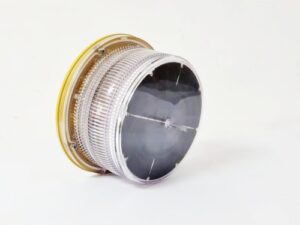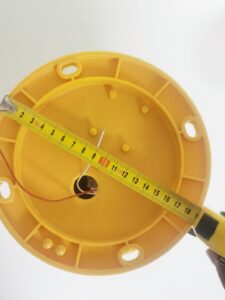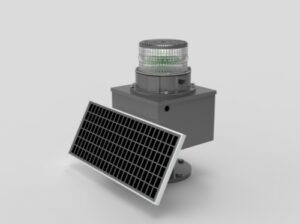In the ever-evolving urban landscape, temporary structures such as cranes have become an indispensable part of construction. These towering mechanisms, while critical for progress, can pose significant risks to aerial navigation. As such, understanding the guidelines for crane marking, as outlined in “CHAPTER 14. MARKING AND LIGHTING TEMPORARY STRUCTURES”, is of paramount importance to ensure safety in the skies.

Crane Marking
CHAPTER 14. MARKING AND LIGHTING TEMPORARY STRUCTURES
14.4 Lighting Standards.
Lighting is used to increase conspicuity of structures for day or nighttime conditions and must be visible to a pilot approaching in any direction. When a temporary structure cannot be removed from site or lowered below the no-effect height, the addition of lighting will be used to alert pilots of their presence. Generally, red lights are recommended during the hours between sunset and sunrise and periods of reduced visibility, using marking for the remainder of the time with occasional exceptions. Lights must be mounted at the highest point of the structure, and in cases of more extensive structures additional lights may be necessary at intermediate levels and furthest horizontal points (i.e., horizontal boom ends, etc.) to clarify the outline of the structure (see Figure A-31).

1. Structures 150 feet (45.72 m) AGL or less. Two or more steady-burning or flashing red (L- 810/L-810 F) lights should be installed on the highest part of the structure in a manner to ensure an unobstructed view of one or more lights by a pilot.
2. Structures exceeding 150 feet (45.72 m) AGL and not more than 350 feet (106.68 m) AGL. At least one red flashing (L-864) light should be installed on the highest part of the structure and intermediate levels of one or more flashing red lights (L-810 F) should be mounted in a manner to ensure an unobstructed view of one or more lights by a pilot.
a. . The number of light levels required is determined by the height of the structure, including all appurtenances, as shown in, Figure A-6. The number of lights on each level is determined by the shape and width of the structure. At least two or more of these lights (L-810 F) should be mounted diagonally or on diametrically opposite positions to ensure an unobstructed view of at least one light at each level by a pilot approaching in any direction. These lights should be configured to flash simultaneously with the L-864 flashing light on the top of the structure at a rate of 30 flashes per minute (fpm) (± 3 fpm). Steady burning lights (L-810) and red flashing lights (L-864) are not used as intermediate level lights on these types of structures. Mounting Intermediate Level Lights
3. Structures exceeding 350 feet (106.68 m) AGL. At least one red flashing (L-864) light should be installed on the highest part of the structure in a manner to ensure an unobstructed view of one or more lights by a pilot. In addition, intermediate levels of lights of flashing red (L-864) will be required.
a. . The number of light levels required is determined by the height of the structure, including all appurtenances, as shown in, Figure A-6. The number of lights on each level is determined by the shape and width of the structure. At least two or more of these lights (L-864) should be mounted diagonally or on diametrically opposite positions to ensure an unobstructed view of at least one light at each level by a pilot approaching in any direction. These lights should be configured to flash simultaneously with the L-864 flashing light on the top of the structure at a rate of 30 flashes per minute (fpm) (± 3 fpm). Steady burning lights are not used on these types of structures. Intermediate Levels Lights
14.4.1 Construction Cranes or Rigs (Oil and Drilling).
When a crane or rig cannot be removed from site or lowered below the no-effect height, the addition of lighting will be used to alert pilots of their presence during the hours between sunset and sunrise and periods of reduced visibility. Lights must be mounted at the highest point, and in cases of more extensive structures additional lights may be necessary at intermediate levels and furthest horizontal (i.e., horizontal boom ends, etc.) points to clarify the outline of the structure (see Figure A-32).

1. Systems. Steady burning and flashing red lights (L-864/L-810) may be used to light cranes and rigs. High-intensity lights (L-856) are not recommended.
2. Display. The flashing light (L-864) should be displayed on the highest point, and the steady light (L-810) at the ends of boom, and other various locations along the top of the structure to best define the outline. Additionally, in certain cases, intermediate level lighting or sidelights (L-810) may be required. For construction cranes with angular booms, the lights must be mounted on a pivot axis so the fixture remains level when the boom tilts to ensure the lights remain level and is not obscured by the structure.
3. Exceptions.
a. Architectural lighting or floodlights may be used in addition to, but not in place of, standard lighting provided they do not cause an adverse effect on the obstruction light fixture’s photometrics and do not result in an obscured view of one of more obstruction lights by a pilot.
b. In some cases, the boom or rig may be lowered below the no-effect height or removed from site, and nighttime lighting is not required.
14.4.2 Container Cranes.
1. These structures are generally used in brightly lit areas, however lighting must be used to alert pilots of the current configuration and presence of the obstruction during the hours between sunset and sunrise and periods of reduced visibility. Extensive structures require additional lights at intermediate levels and furthest horizontal points, (i.e., horizontal boom ends, etc.), as well as horizontal mid-points as necessary, to clarify the outline of the structure for pilots approaching from any direction.
2. Systems. Medium intensity white lights (L-865) may be used, however high-intensity lights (L-856) are not recommended.
3. Display. The lights should be displayed on the highest point, ends of boom, and other various ways to best define the size and shape of the structure. Lights must be mounted at the highest point at all times during usage. For large container cranes with angular booms, the lights must be mounted on a pivot axis so the fixture remains level when the boom tilts to ensure the lights remain level and is not obscured by the structure (see Figure A-33).

4. Exceptions. Architectural lighting or floodlights may be used in addition to, but not in place of, standard lighting provided they do not cause an adverse effect on the obstruction light fixture’s photometric and do not result in an obscured view of one of more obstruction lights by a pilot.
14.5 Operational Characteristics.
When using flashing lights, the lights should flash simultaneously.
CHAPTER 15. MARKING AND LIGHTING EQUIPMENT AND INFORMATION
15.1 Purpose.
This chapter lists documents relating to obstruction marking and lighting systems and where they may be obtained.
15.2 Paint Standard.
15.2.1 Paint and aviation colors/gloss, referred to in this AC, with the exception of wind turbines, should conform to Aerospace Material Specification Standard, SAE-AMS- STD-595, Colors Used in Government Procurement, previously known as FED-STD- 595 (cancelled February 14, 2017). Wind turbines must meet the standards in Chapter 13, paragraph 13.4, of this AC.
15.2.2 Approved colors must be formulated without using lead, zinc chromate, or other heavy metals to match international aviation orange, white, and yellow, as listed in Table 3-1. All coatings must be manufactured and labeled to meet Federal Environmental Protection Act Volatile Organic Compound(s) guidelines, including the National Volatile Organic Compound Emission Standards for architectural coatings.
1. Exterior Acrylic Waterborne Paint. Coatings should be ready-mixed, 100 percent acrylic, exterior latex formulated for application directly to galvanized surfaces. Ferrous iron and steel or non-galvanized surfaces must be primed with a manufacturer-recommended primer compatible with the finish coat.
2. Exterior Solvent-Borne Alkyd-Based Paint. Coatings should be ready-mixed, alkyd-based, exterior enamel for application directly to non-galvanized surfaces, such as ferrous iron and steel. Galvanized surfaces must be primed with a manufacturer-recommended primer compatible with the finish coat.
Table 15-1. Aerospace Material Specification Standard, SAE-AMS-STD-595
| Color | Number |
| Orange | EA 12197 |
| White | EA 17875 |
| Yellow | EA 13538 |
15.3 Availability of Specifications and Advisory Circulars.
1. Federal and military specifications describing the technical characteristics of various paints and their application techniques are available through the ASSIST Database at https://assist.dla.mil/online/start/. ASSIST is a robust, comprehensive website used by standardization management activities to develop, coordinate, distribute, and manage defense and federal specifications and standards, military handbooks, commercial item descriptions, data item descriptions, and related technical documents prepared in accordance with the policies and procedures of the Defense Standardization Program (DSP).
2. For Federal Product Description line items only (for download, refer to ASSIST), use the following Uniform Resource Locator (URL):
Summary: The essence of maintaining safe airspace is adaptability. As we continue to expand and build upwards, it’s crucial that temporary structures like cranes are properly marked and lit to ensure that pilots can easily identify and avoid them. Red lighting is the predominant recommendation for nighttime, with strategic placements not just at the top, but throughout the structure to give a clear idea of its dimensions. With guidelines in place and diligently followed, our skies can remain as safe as our cities are ambitious.
WelandSignal AFS400: The Pinnacle of Temporary Structure Lighting

When it comes to marking and lighting temporary structures, WelandSignal’s AFS400 stands unrivaled as the preferred choice in aviation obstruction lights. A testament to cutting-edge design and efficiency, the AFS400 boasts an integrated design equipped with built-in solar panels and a lithium iron phosphate battery. Say goodbye to cumbersome cables and extended setups, as this compact unit offers robust illumination without the added weight. Trust in WelandSignal to illuminate the skies, ensuring safety and clarity in all conditions.





